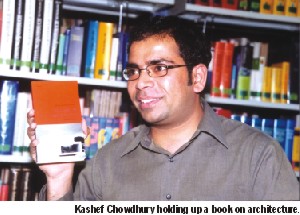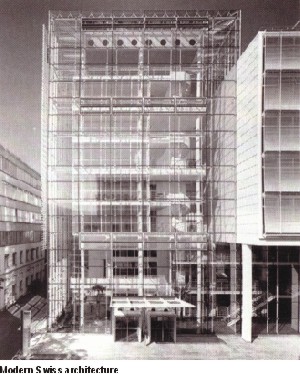| |
Forging
Ahead While
Preserving the Old
Fayza
Haq
 Kashef
Chowdhury, who presented 26 films of 15 minutes duration,
on Swiss architecture at the Goethe Institut from 4th to
6th May, talked of how the Bangladeshi builders could learn
from the films. Chowdhury said, "Films, books and travels
are elements that inspire architects. The film is about
the type of problems that city authorities often face regarding
making buildings, how architects work within stringent regulations,
and how they manage to come up with interesting solutions.
From these films one learns how one can come up with various
solutions which are interactive with the city, as well as
gives back to the city." Kashef
Chowdhury, who presented 26 films of 15 minutes duration,
on Swiss architecture at the Goethe Institut from 4th to
6th May, talked of how the Bangladeshi builders could learn
from the films. Chowdhury said, "Films, books and travels
are elements that inspire architects. The film is about
the type of problems that city authorities often face regarding
making buildings, how architects work within stringent regulations,
and how they manage to come up with interesting solutions.
From these films one learns how one can come up with various
solutions which are interactive with the city, as well as
gives back to the city."
Chowdhury
points out that the materials used in Bangladesh are sometimes
different from those used in Europe. In Switzerland, he
gives an example, wood is predominant. "They also use
concrete and brick as we do here. In Bangladesh wood cannot
be used that much due to seasonal changes," he said.
 One
objective for making the films was to create an awareness
of architecture. In Europe general people are exposed to
and are more conversant with films, music and architecture
unlike people in this part of the world. Chowdhury however
believes that given a chance the Dhakaites, particularly
those interested in the art of making buildings, would also
appreciate the films. "The films are technical but
they have a universal appeal at the same time. There are
a good number of people, who are not architects by profession,
but are interested in how buildings are made. Besides, since
ordinary people have limited access to books on architecture,
films can be a good option for them," he adds. One
objective for making the films was to create an awareness
of architecture. In Europe general people are exposed to
and are more conversant with films, music and architecture
unlike people in this part of the world. Chowdhury however
believes that given a chance the Dhakaites, particularly
those interested in the art of making buildings, would also
appreciate the films. "The films are technical but
they have a universal appeal at the same time. There are
a good number of people, who are not architects by profession,
but are interested in how buildings are made. Besides, since
ordinary people have limited access to books on architecture,
films can be a good option for them," he adds.
The
films give the viewers an opportunity to go beyond the confines
of Bangladesh and there they can see beautiful, neat and
useful homes, offices and schools. A land owner or a person
interested in buying an apartment or building a house would
find these films interesting and informative. Through the
films, Chowdhury believes, not only can we bring in new
ideas from overseas, but export our own culture in arts
and architecture abroad. Thus the films prepare a more mature
clientele and architects can work with them in a more fruitful
way, creating a better-built environment in general.
 Asked
if he felt that the buildings in Europe are better planned
as there the governments are actively involved in urban
planning, Chowdhury answered in the affirmative, but the
stringent rules don't stop the architects from coming up
with creative, beautiful and imaginative constructions.
On the River Tames alone, he said, there are 27 approving
authorities. There have been instances, he said, where the
city authorities have opened up possibilities to relax some
of the regulations. Europe, says Chowdhury, has preserved
the past and gone ahead with experimentation. "This
interesting blend of things gives us in the East something
to learn from, as we are not preserving our built heritage.
Dhaka city we know today is not what we knew ten years ago.
We keep losing our urban centres and land marks; and now
we think that change is good, in the sense that we have
become modern. A change is good but in a limited way. In
Europe we see the possibilities of preserving old, coveted
architecture while adding on newly planned buildings,"
he adds. Asked
if he felt that the buildings in Europe are better planned
as there the governments are actively involved in urban
planning, Chowdhury answered in the affirmative, but the
stringent rules don't stop the architects from coming up
with creative, beautiful and imaginative constructions.
On the River Tames alone, he said, there are 27 approving
authorities. There have been instances, he said, where the
city authorities have opened up possibilities to relax some
of the regulations. Europe, says Chowdhury, has preserved
the past and gone ahead with experimentation. "This
interesting blend of things gives us in the East something
to learn from, as we are not preserving our built heritage.
Dhaka city we know today is not what we knew ten years ago.
We keep losing our urban centres and land marks; and now
we think that change is good, in the sense that we have
become modern. A change is good but in a limited way. In
Europe we see the possibilities of preserving old, coveted
architecture while adding on newly planned buildings,"
he adds.
Chowdhury
then dwells on the need for preservation of old buildings
in Bangladesh. Buildings of great architectural values like
Nawab Bari, Boro Katra and Rup Lal House are being allowed
to decay. The fabric of Old Dhaka is not being preserved
as high rise buildings are mushrooming hither and thither.
Even the Parliament building has been undergoing changes
that are not sympathetic to the original design. In Paharpur
the old terracotta relief work have been removed and replaced
by replicas. Relics from the monuments of Moinamati are
being sold to foreigners in the bazaars in Gulshan and Bonani.
Laws and regulations are there, but they are not being enforced.
People have to be made aware of how important it is to preserve
our heritage along with creating new designs," he says.
|

 Kashef
Chowdhury, who presented 26 films of 15 minutes duration,
on Swiss architecture at the Goethe Institut from 4th to
6th May, talked of how the Bangladeshi builders could learn
from the films. Chowdhury said, "Films, books and travels
are elements that inspire architects. The film is about
the type of problems that city authorities often face regarding
making buildings, how architects work within stringent regulations,
and how they manage to come up with interesting solutions.
From these films one learns how one can come up with various
solutions which are interactive with the city, as well as
gives back to the city."
Kashef
Chowdhury, who presented 26 films of 15 minutes duration,
on Swiss architecture at the Goethe Institut from 4th to
6th May, talked of how the Bangladeshi builders could learn
from the films. Chowdhury said, "Films, books and travels
are elements that inspire architects. The film is about
the type of problems that city authorities often face regarding
making buildings, how architects work within stringent regulations,
and how they manage to come up with interesting solutions.
From these films one learns how one can come up with various
solutions which are interactive with the city, as well as
gives back to the city." One
objective for making the films was to create an awareness
of architecture. In Europe general people are exposed to
and are more conversant with films, music and architecture
unlike people in this part of the world. Chowdhury however
believes that given a chance the Dhakaites, particularly
those interested in the art of making buildings, would also
appreciate the films. "The films are technical but
they have a universal appeal at the same time. There are
a good number of people, who are not architects by profession,
but are interested in how buildings are made. Besides, since
ordinary people have limited access to books on architecture,
films can be a good option for them," he adds.
One
objective for making the films was to create an awareness
of architecture. In Europe general people are exposed to
and are more conversant with films, music and architecture
unlike people in this part of the world. Chowdhury however
believes that given a chance the Dhakaites, particularly
those interested in the art of making buildings, would also
appreciate the films. "The films are technical but
they have a universal appeal at the same time. There are
a good number of people, who are not architects by profession,
but are interested in how buildings are made. Besides, since
ordinary people have limited access to books on architecture,
films can be a good option for them," he adds.  Asked
if he felt that the buildings in Europe are better planned
as there the governments are actively involved in urban
planning, Chowdhury answered in the affirmative, but the
stringent rules don't stop the architects from coming up
with creative, beautiful and imaginative constructions.
On the River Tames alone, he said, there are 27 approving
authorities. There have been instances, he said, where the
city authorities have opened up possibilities to relax some
of the regulations. Europe, says Chowdhury, has preserved
the past and gone ahead with experimentation. "This
interesting blend of things gives us in the East something
to learn from, as we are not preserving our built heritage.
Dhaka city we know today is not what we knew ten years ago.
We keep losing our urban centres and land marks; and now
we think that change is good, in the sense that we have
become modern. A change is good but in a limited way. In
Europe we see the possibilities of preserving old, coveted
architecture while adding on newly planned buildings,"
he adds.
Asked
if he felt that the buildings in Europe are better planned
as there the governments are actively involved in urban
planning, Chowdhury answered in the affirmative, but the
stringent rules don't stop the architects from coming up
with creative, beautiful and imaginative constructions.
On the River Tames alone, he said, there are 27 approving
authorities. There have been instances, he said, where the
city authorities have opened up possibilities to relax some
of the regulations. Europe, says Chowdhury, has preserved
the past and gone ahead with experimentation. "This
interesting blend of things gives us in the East something
to learn from, as we are not preserving our built heritage.
Dhaka city we know today is not what we knew ten years ago.
We keep losing our urban centres and land marks; and now
we think that change is good, in the sense that we have
become modern. A change is good but in a limited way. In
Europe we see the possibilities of preserving old, coveted
architecture while adding on newly planned buildings,"
he adds.